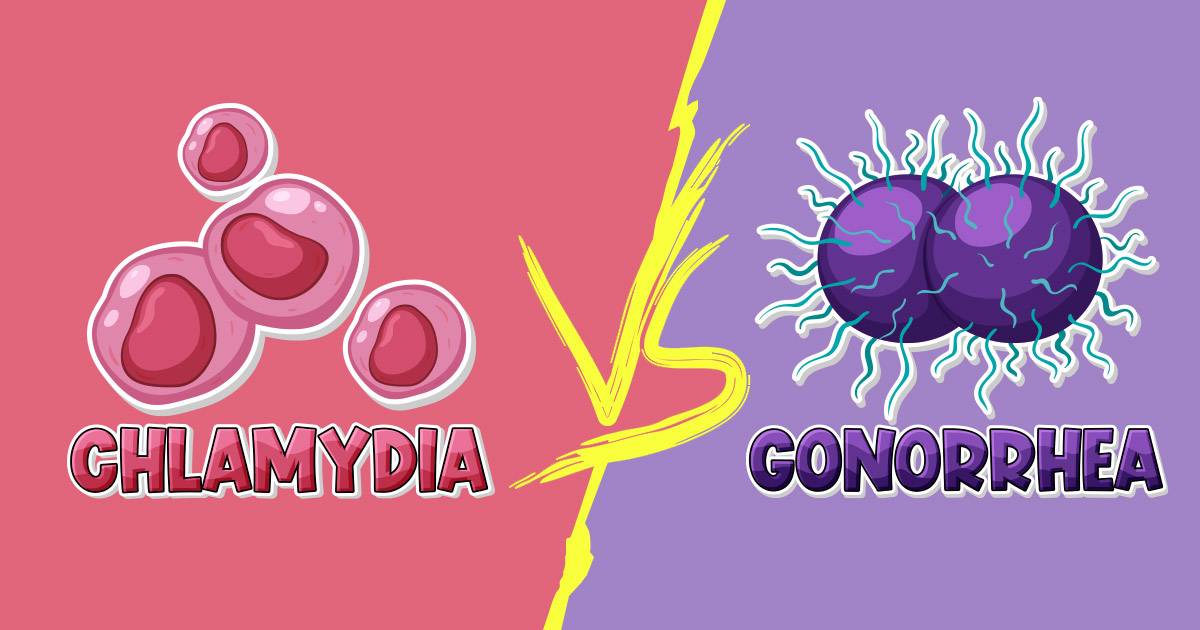Chlamydia vs. Gonorrhea: What’s the Difference? Symptoms, Treatment & More

Talking about sexually transmitted diseases (STDs) can feel uncomfortable for many because of their personal nature. This discomfort often means people don’t talk about them enough, leading to missed signs and symptoms. A recent study showed that many people with STDs don’t even know they have them, partly because discussing these issues is awkward for most. Recognizing the symptoms early is key to getting the right treatment quickly and stopping the spread to others.
We’ll look at two common STDs: chlamydia and gonorrhea. Understanding the differences and similarities between these infections is important for knowing how serious they can be and why it’s crucial to treat them promptly.
What is Chlamydia?
Chlamydia is a very common sexually transmitted infection caused by the bacterium Chlamydia trachomatis. It spreads through sexual activities like vaginal, anal, or oral sex. Often, people with chlamydia don’t notice any symptoms, which makes it easy to unknowingly pass it to others.
When symptoms do show up, women might experience unusual vaginal discharge, burning when urinating, pain during sex, lower abdominal pain, and bleeding between periods. Men can have discharge from the penis, a burning feeling during urination, and sometimes pain or swelling in one or both testicles.
What is Gonorrhea?
Gonorrhea is another common STD caused by the bacterium Neisseria gonorrhoeae. It spreads similarly to chlamydia through sexual contact and can affect the genitals, mouth, and throat.
Symptoms of gonorrhea can be similar to those of chlamydia but with some differences.
Women may notice a thicker, yellow or green discharge, discomfort while urinating, pain during sex, and bleeding between periods. Men may experience a white, yellow, or green discharge from the penis, painful urination, and sometimes painful or swollen testicles.
Gonorrhea vs Chlamydia Symptoms: The Importance of Telling Them Apart
Identifying the differences between chlamydia and gonorrhea is vital for proper treatment and preventing health complications. Both infections require specific antibiotics, and a misdiagnosis can lead to serious consequences. Here’s a closer look at the symptoms and why it’s important to recognize them:
Discharge
Chlamydia often causes a light, watery discharge, whereas gonorrhea typically results in a thicker discharge that may be yellow or green. This difference can help in identifying which infection one might have.
Pain
Both STDs can cause pain, but the way they present might differ. With chlamydia, you might experience mild discomfort during urination or sex, while gonorrhea can cause more intense pain in these situations.
Other Symptoms in Women
- Chlamydia: Some women might notice lower abdominal pain and bleeding between periods, which can be mistaken for regular menstrual issues.
- Gonorrhea: Women may experience more frequent bleeding between periods and a thicker vaginal discharge, which can become quite noticeable.
Other Symptoms in Men
- Chlamydia: Men might see a discharge from the penis and occasionally feel pain or swelling in the testicles.
- Gonorrhea: Often presents with a more visible discharge that is white, yellow, or green, along with potential testicular swelling and pain.
If left untreated, both infections can lead to significant health problems, such as pelvic inflammatory disease in women and infertility in both genders. Recognizing these symptoms early is crucial for effective treatment and reducing the risk of spreading the infection.
Treatment Options for Chlamydia and Gonorrhea: Which is Worse?
Both gonorrhea and chlamydia are serious sexually transmitted infections (STIs) that can lead to major health problems if not treated. Deciding which is worse depends on their symptoms, possible complications, and how they are treated.
Knowing how to treat chlamydia and gonorrhea is important to help manage these infections and avoid further health problems.
Chlamydia Treatment
Chlamydia is treated with antibiotics aimed at killing the bacteria. Here are the main treatments:
- Azithromycin: This is taken as a single dose, making it easy to use. It stops the bacteria from growing, helping to clear the infection when used properly.
- Doxycycline: Taken over 7 days, with two doses each day. It’s effective, especially if the infection doesn’t go away easily.
Sometimes, doctors might prescribe other antibiotics like erythromycin if you’re allergic to the main ones.
Gonorrhea Treatment
Treating gonorrhea is a bit more complicated because some strains resist antibiotics. Here’s how it’s usually treated:
- Ceftriaxone: Given as a shot, it targets the gonorrhea bacteria directly and is very strong.
- Azithromycin: Taken by mouth along with ceftriaxone to help clear any chlamydia infection that might also be present.
If ceftriaxone isn’t available, other options like gentamicin might be used, but you’ll need to discuss these with your doctor.
Finishing the full antibiotic course is crucial to ensure the infection is completely gone and to prevent resistance. After treatment, follow-up testing is often suggested to make sure the infection is cleared, especially for gonorrhea.
Catching these infections early and treating them quickly can prevent serious issues like pelvic inflammatory disease or infertility. Regular check-ups are vital, especially if you’re sexually active, as they help catch infections early. If you notice any symptoms, see a doctor right away. This not only helps you stay healthy but also prevents spreading the infection to others.
STI Symptoms Awareness: Key to Better Treatment
Knowing the differences in symptoms between chlamydia and gonorrhea is very important for getting the right treatment and avoiding bigger health problems. By understanding these differences, you can get the right medical help quickly, ensuring that the correct antibiotics are used to fight the infection effectively. This helps clear up the infection and also cuts down on spreading these STIs.
Chlamydia often shows mild or no symptoms, while gonorrhea usually has more obvious signs. Being aware of these can lead to faster diagnosis and treatment. Regular health check-ups and paying attention to any changes in your body are crucial for keeping your sexual health in check. By staying informed and taking action quickly, you can protect yourself and those around you, leading to a healthier life.
